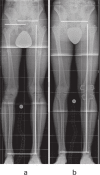Growth arrest: leg length correction through temporary epiphysiodesis with a novel rigid staple (RigidTack)
- PMID: 34334047
- PMCID: PMC9948429
- DOI: 10.1302/0301-620X.103B8.BJJ-2020-1035.R4
Growth arrest: leg length correction through temporary epiphysiodesis with a novel rigid staple (RigidTack)
Abstract
Aims: Temporary epiphysiodesis (ED) is commonly applied in children and adolescents to treat leg length discrepancies (LLDs) and tall stature. Traditional Blount staples or modern two-hole plates are used in clinical practice. However, they require accurate planning, precise surgical techniques, and attentive follow-up to achieve the desired outcome without complications. This study reports the results of ED using a novel rigid staple (RigidTack) incorporating safety, as well as technical and procedural success according to the idea, development, evaluation, assessment, long-term (IDEAL) study framework.
Methods: A cohort of 56 patients, including 45 unilateral EDs for LLD and 11 bilateral EDs for tall stature, were prospectively analyzed. ED was performed with 222 rigid staples with a mean follow-up of 24.4 months (8 to 49). Patients with a predicted LLD of ≥ 2 cm at skeletal maturity were included. Mean age at surgery was 12.1 years (8 to 14). Correction and complication rates including implant-associated problems, and secondary deformities as well as perioperative parameters, were recorded (IDEAL stage 2a). These results were compared to historical cohorts treated for correction of LLD with two-hole plates or Blount staples.
Results: The mean LLD was reduced from 25.2 mm (15 to 45) before surgery to 9.3 mm (6 to 25) at skeletal maturity. Implant-associated complications occurred in 4/56 treatments (7%), and secondary frontal plane deformities were detected in 5/45 legs (11%) of the LLD cohort. Including tall stature patients, the rate increased to 12/67 legs (18%). Sagittal plane deformities were observed during 1/45 LLD treatments (2%). Compared to two-hole plates and Blount staples, similar correction rates were observed in all devices. Lower rates of frontal and sagittal plane deformities were observed using rigid staples.
Conclusion: Treatment of LLD using novel rigid staples appears a feasible and promising strategy. Secondary frontal and sagittal plane deformities remain a potential complication, although the rate seems to be lower in patients treated with rigid staples. Further comparative studies are needed to investigate this issue. Cite this article: Bone Joint J 2021;103-B(8):1428-1437.
Keywords: Adolescents; Children; Growth arrest; Leg length discrepancy; Tall stature; Temporary epiphysiodesis.
Figures







Similar articles
-
Comparison of Temporary Epiphysiodesis With RigidTacks™ and Blount-Staples in a Porcine Animal Model Using Magnetic Resonance Imaging.J Orthop Res. 2020 May;38(5):946-953. doi: 10.1002/jor.24532. Epub 2019 Nov 26. J Orthop Res. 2020. PMID: 31743488
-
Sagittal plane deformity after temporary epiphysiodesis of the distal femur for correcting limb length discrepancy.J Orthop Sci. 2020 May;25(3):472-476. doi: 10.1016/j.jos.2019.05.002. Epub 2019 May 31. J Orthop Sci. 2020. PMID: 31155443
-
Temporary epiphyseodesis for limb-length discrepancy. 8- to 15-year follow-up of 34 children.Acta Orthop. 2014 Dec;85(6):626-32. doi: 10.3109/17453674.2014.960646. Epub 2014 Sep 5. Acta Orthop. 2014. PMID: 25191935 Free PMC article.
-
Are percutaneous epiphysiodesis and Phemister technique effective in the treatment of leg-length discrepancy? A systematic review.J Pediatr Orthop B. 2024 Nov 1;33(6):543-551. doi: 10.1097/BPB.0000000000001160. Epub 2024 Feb 5. J Pediatr Orthop B. 2024. PMID: 38324644 Free PMC article.
-
[Guided growth in children and adolescents. Correction of leg length discrepancies and leg axis deformities].Orthopade. 2014 Mar;43(3):267-84. doi: 10.1007/s00132-014-2270-x. Orthopade. 2014. PMID: 24627039 Review. German.
Cited by
-
Radiographic reference values of the central knee anatomy in 8-16-year-old children.Acta Orthop. 2023 Jul 31;94:393-398. doi: 10.2340/17453674.2023.15336. Acta Orthop. 2023. PMID: 37522246 Free PMC article.
-
Tension-band Plating for Leg-length Discrepancy Correction.Strategies Trauma Limb Reconstr. 2022 Jan-Apr;17(1):19-25. doi: 10.5005/jp-journals-10080-1547. Strategies Trauma Limb Reconstr. 2022. PMID: 35734032 Free PMC article.
-
No evidence of intra-articular knee deformity following growth arrest through temporary epiphysiodesis - a retrospective study of 81 patients.J Orthop Surg Res. 2025 May 17;20(1):476. doi: 10.1186/s13018-025-05875-0. J Orthop Surg Res. 2025. PMID: 40380273 Free PMC article.
-
Antegrade Intramedullary Femoral Lengthening and Distal Temporary Hemiepiphysiodesis for Combined Correction of Leg Length Discrepancy and Coronal Angular Deformity in Skeletally Immature Patients.J Clin Med. 2023 Apr 21;12(8):3022. doi: 10.3390/jcm12083022. J Clin Med. 2023. PMID: 37109358 Free PMC article.
-
[Options and limits of leg length correction in paediatric orthopaedics].Orthopadie (Heidelb). 2023 Sep;52(9):719-728. doi: 10.1007/s00132-023-04420-3. Epub 2023 Aug 10. Orthopadie (Heidelb). 2023. PMID: 37561147 Review. German.
References
-
- Blount WP, Clarke GR. Control of bone growth by epiphyseal stapling; a preliminary report. J Bone Joint Surg Am. 1949;31-A(3):464–478. - PubMed
-
- Stevens PM. Guided growth: 1933 to the present. Strategies Trauma Limb Reconstr. 2006;1(1):29–35.
-
- Stevens PM, Maguire M, Dales MD, Robins AJ. Physeal stapling for idiopathic genu valgum. J Pediatr Orthop. 1999;19(5):645–649. - PubMed
-
- Raab P, Wild A, Seller K, Krauspe R. Correction of length discrepancies and angular deformities of the leg by blount's epiphyseal stapling. Eur J Pediatr. 2001;160(11):668–674. - PubMed
-
- Lykissas MG, Jain VV, Manickam V, Nathan S, Eismann EA, McCarthy JJ. Guided growth for the treatment of limb length discrepancy: a comparative study of the three most commonly used surgical techniques. J Pediatr Orthop B. 2013;22(4):311–317. - PubMed

